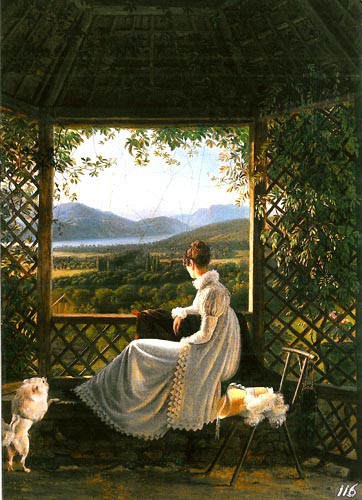On 27 May, 1813, Hortense de Beauharnais left her children, Napoleon Louis and Louis-Napoleon, in the care of her mother, former French empress Josephine, and left to take the waters in Aix-en-Savoie (today known as Aix-les-Bains). Amongst her travelling party was her loyal friend, Adèle de Broc. Whilst there, on 10 June, the two ladies went for a stroll near the Grésy waterfall. “I went first, the board was unsteady. I turned around: Good Lord! What a terrible sight! My friend, taken away by the current, had disappeared from view… Her lifeless body was retrieved […] She was no more! What despair! Once again I found myself more alone than ever, without my friend who had helped me through all my hardships!”* To take the queen’s mind off her grief, her reader, Louise Cochelet, wrote a letter to the Lyonnais painter François Fleury Richard in July, entreating him to come and paint a portrait of Hortense; the painter had already been solicited for such a service, without result.
The artist arrived in the company of his student, Antoine Duclaux, who was also from Lyon. The former produced a sketch of the young lady playing music, whilst the student began work on a portrait from behind, with Hortense seated under a pergola, surveying the scenery stretched out before her. The viewer is moved to ponder whether it was the grief that prevented her from showing her face. There is also a little dog in the painting, its paws balanced on the bench on which Hortense is seated: could it be there to offer her some comfort?
The number 116 appears in the bottom right-hand corner of the portrait: this refers to the room in which it is still found today, in Schloss Arenenberg. The room in question is the boudoir between the queen’s bedchambers and her study, located on the first floor of the castle.
Adèle de Broc is interred in the chapel of the church in Saint-Leu-la-Forêt: when Napoleon III undertook to rebuild the by-that-time ruined church and make it worthy of the imperial family (Louis Bonaparte is also buried there), the chapel was retained. De Broc’s sister, the wife of Maréchal Ney, is buried at her side.
* Mémoires de la reine Hortense publiés par le prince Napoléon, Paris, Plon, 1927, p. 166
Christina Egli (tr. H.D.W.)
Curator, Napoleonmuseum, Thurgau, Schloss und Park Arenenberg, Salenstein
April 2011


